This is, by far, the most unexpected choice to end up here if you were trying to figure out what someone would list in their favorites. And I will concede it deserves its slot least when Avatar:TLA and Fullmetal Alchemist were barred from presentation. But that is why it is Number 10.
The 10 slot was the only one I really struggled with at length. And it came down to a four way tie. And as I mentioned in my introduction to this review series, the thing that put it over the top was how much I identified with the characters here, one in particular. Which, if you’ve noted my aesthetic already, probably isn’t a surprise.
There’s also a very simple reason: I love big fuckin ships with big fuckin guns duking it out as old ships of the line. Hell, that was the ENTIRE reason I was a loyal Pirates of the Caribbean MMO player, the chance to shoot and sink warships with my decked out cannonade. My favorite episode of “Dogfights”, which if you’re unfamiliar is about fighter plane combat (back before the History channel became about aliens, remember those days?) was the naval battle of Taffy 3. I’m also a sci-fi lover, as evidenced by many references I make, so Ars Nova really hits my blind spots.
Yet, while I do recognize I have those blind spots, and objectively, sure, I could rip apart the flaws and it would probably score about Noragami levels of quality in the end. But this is just a list about what I like, and I’m not going to go looking for problems when I’m having too much fun.
And, of course, the ship avatars. Ahem. “Dataport Doll” is an old name I used in Andromeda fan circles, many of which probably don’t even exist anymore. It is a reference to Rommie, the Andromeda’s avatar, whom was given the nickname “Rom-Doll” by the ship engineer. And the dataport which was the way Humans could interact with AI minds. So the “Mental Models” in Ars Nova are, to me, just a wonderful anime extension of the Ship’s Avatars from Andromeda. So this series hits me in all the right feels (fitting, I suppose, as Andromeda was heavily influenced by anime).
Ars Nova is a series that just sticks to your brain. It is a visual masterpiece, and while the pure-CG nature can be off-putting, if you could handle Sidonia, this show is far, far less intrusive. The loving detail of the ships really could NOT have been done with line art, not on a reasonable budget, and the color schemes of the ships and the fights exploit the CG nature of the series remarkably. Combat is a wonderful blend of the naval and sci-fi, giving us an aesthetic to fights that are one part Red October, one part Star Wars, and one part Tron.
Reminder, sailors: Here there be spoilers.
That was…that was Kind of Clever, Show.
Another thing that doesn’t hurt is the predominantly female cast of characters. And, yes, I’m defending the contrivance again due to the nature of the cast. Human ships are generally regarded as female, erego, logic dictates their personas will be female as well.
It is the near future and Humanity has been pushed from the oceans by the “Fleet of Fog”, mysterious alien ships which mirror the fleets of World War 2, that just appeared in Earth’s oceans. They shut down commerce, communication, and most space satellites which has left the various landmasses isolated from each other. For an island nation like Japan, this threat is particularly troublesome.
For reasons that remain unknown, however, the Fog has not attacked the coastal settlements of humanity (a relief as the majority of the Human population currently lives within 100 kilometers of the ocean). but neither will they allow cargo runs or any other form of transit. In effect, the Fog has said to Humanity “go to your room” and is enforcing this power by the barrel of a gun. Why is this? No one’s really sure. Not even the Fog themselves. They’re simply obeying orders. Everything has been pre-programmed into them, from their new rules regarding the oceans and the very fact they have adopted the form of old Human vessels, in the form of what they call “the Admiralty Code”.
This premise alone is enough to make a series over. Think of the social upheaval if all our underwater cables were cut, all radio transmissions jammed, economic activity (still handled primarily by sea) halted. Such a world is full of potential, and you could argue that one of Ars Nova’s flaws is not fleshing this out more.
But Ars Nova is a small tale of this world. It follows Chihaya Gunzou, captain of the I-401, a Fog submarine that appeared in Japan, surrendering to Human forces, and waited for him to arrive and assume command of her. We’re told Gunzou’s father disappeared into the Fog fleet (sailors still call him a traitor, but no hard evidence supports this), and suddenly a Fog vessel arrives that will only obey his son’s orders? These two events are obviously linked.
As such, the I-401 is Humanity’s only true weapon against the Fog, and the series follows their exploits, primarily a mission to deliver a prototype weapon to America for mass production. In this it fits pieces together nicely. Japan has had access to a Fog ship, something that probably no other nation has, and has developed a weapon to combat them appropriately. But Japan is not a resource rich country, they need the industrial powers to mass produce this weapon to drive back the Fog.
But the primary focus of the show is the ship avatars, the Mental Models. They are the primary characters, more so than Gunzou, who is almost here as an obligatory shonen hero, a backdrop in which to frame this series in colors that the audience won’t have to think about it too hard.
Ai Robot
While the premise is one that would lend itself to military themes, and those are present, the true core of the series is the Mental Models, the ship avatars who each go through a journey of discovering their, for lack of a more appropriate term, Humanity.
But let’s address something at the core of this, as it can draw this element into uncomfortable territory. Specifically, the accusation that this is wish fulfillment and objectifying women because they need a man (in this case, protagonist Gunzou) to give them purpose. It even does the sillyness of adding harem elements to a sci-fi show about warships.
In the case of Takao…you won’t get any argument from me. She is an excessively uncomfortable avatar, sexualizing Gunzou in a horribly patronizing way. She even tries to rationalize this away, and yet, while the excuse itself (getting to that) is valid, the way it is framed makes it clear she is using it as a rationalization for woman-feelings of submission. And I was glad when she fucking died. Sort of…but we’ll take what we can get. Takao is indefensible, made all the worse that no one in the show calls her out on it. If the show had been more self-aware about her, perhaps I could sit here and argue the point, but it wasn’t, so I can’t.
At least, as far as Takao goes. Let us never speak of her again if we can help it.
However, and I would emphasize this point, deconstructing her argument from the SPECULATIVE angle could bring her character into focus. The show doesn’t do this, which is why it’s probably better to say Ars Nova uses science fiction as a trapping, and not a theme.
Because at their core, the girls are still AI. Sure, they may be sapient AI, but they are still not Human. As we mentioned in Sidonia, we don’t have the faintest idea of what kind of priorities TRUE AI will possess, if we can even COMPREHEND what such priorities would be.
We are told that the Fog adopted the ships avatars because they needed to understand the concepts of time, tactics, and other things bound to mortal minds. I presume when they mean they don’t understand time, they mean the ability to think of the future and past as abstracts. We see this theme in Episode 3 and 4, where the idea of “regret” is discussed by some of the Fog as being illogical, because what’s done is done and why worry? Why try to learn from it? Still adapting to the ways abstract time can be helpful and harmful. Kongou even makes the observation that if Humanity had had technology that could even COMPETE with the Fog, instead of being roflstomped with brute force, the Fog would likely have lost The War due to their inability to do more than react to immediate threats.
So this brings us back to our tricky question: Accepting that these are AI, is it still objectifying women?
…Probably a little bit (though I actually liked this scene as it was literally a little girl playing dress up with a doll).
Let’s draw on the Andromeda parallel. That series handled its ship avatars in very much the same way, and many of the best episodes of Andromeda were about the issue of AI in its universe. One of the cute quips the show employed was a starship, sapient in its own right, arguing for AI rights. “You ask why we give our starships emotions. Do you truly want a warship incapable of loyalty? Incapable of love?”
And Andromeda was certainly not black and white regarding this. While they often acknowledged that ships were sapient in their own right, counted as sapient beings under law, the argument was raised again and again, “Perhaps the Commonwealth did treat their AI as slaves”.
It’s a way to play with the complexities of the issues at hand. Look at Isaac Asimov’s Bicentennial Man, often regarded as the foundation of “AI Rights” in sci-fi. The court finally ruled, in regards to the personhood of AI, that “any being cannot be denied freedom if it is aware of the concept and desires the state.” And in Andromeda, the AI…they did not really DESIRE the state, that’s the catch. They saw themselves as soldiers, who took oaths to the Commonwealth military, and would die for those oaths. While Asimov seems to lay down a wonderful premise for handling sapient rights…there are still presumptions at the heart of the conclusion that can be played with.
The Mental Models in Ars Nova are very similar. While Takao justifies her 50 Ships of Grey with the idea that a Human commander will know how to “use” her better, we DO see in Hyuuga similar notes. Only instead of being obsessed with Gunzou, she’s obsessed with Iona, so enthralled that a lowly patrol submarine was able to sink her with inferior systems and firepower. Hyuuga even creates her Mental Model in order to better comprehend the feelings. Which basically turns her into a panting puppy sexual predator towards the cute Iona. This would demonstrate that these ‘sexual’ feelings in the Mental Models aren’t sexual as we understand them, but an extension of the core functions their AI already holds, it’s just interpreting them in these ways. Much like you can’t LITERALLY translate Japanese to English or vice versa, it requires a bit of an artistry to make approximations, and so too are these emotions in the AI being reflected in Human behavior as approximation.
This doesn’t make Takao any less uncomfortable, it’s merely a backdrop against which to frame the entire “race” of the Fog. Like Star Trek V or Daleks in Manhattan, sometimes it’s best to pretend certain bits of canon don’t exist, and Takao is that for Ars Nova.
While Hyuuga, Takao, and Kirishima all have varying journeys, the big ones are Iona, Haruna, and Kongou.
I loved the little pavilion that the girls shared tea at in their “chats” with each other. Not only very blank and cold like the machines they were supposed to be, but it gave us a unique way of exploring inner monologue while keeping the pace of the fights up. On top of this, in many shots the shadows cast by the roof and pillars would cast a pattern similar to the old Japanese Imperial Flag, and that was a touch so obvious in hindsight, a good use of the space they had.
Shazam
Haruna wins my seconds spot, she’s such an adorable kuudere character. Not to mention bearing striking resemblance to Larxene from Kingdom Hearts (otherwise known as best girl).
We encounter her much further along this journey to humanity than her counterparts, although for the entirety of the Fog it has been progressing for some time by the series start. Or perhaps it might be more accurate to say Haruna’s personality type is more open to Human culture. When we meet her, she is cataloging words in a grim sort of ritual. As she kills people, she often records their last words, trying better to understand them. We know that the Fog understand death, they strictly forbid the killing of civilian targets, provided they aren’t running the blockades (though collateral damage is acceptable). But she is interested in the Human view of death as a concept, more in the abstract and less on the mechanical on-off switch of life. And it’s not just death, but this does seem to be a focus of interest. As established, one reason the ships took avatars was to understand the passage of time.
In this, Haruna is a beautiful juxtaposition. As I said, her archetype is mostly the “kuudere” girl. But whereas kuudere are often displayed as “the least human”, by means of being cold, off-putting, and apathetic, here Haruna has been brilliantly cast as the MOST Human of the Fog. Indeed she is the only one who actively studies Humanity in her own time. The only one who comes close is Takao, and THAT is only after she’s beaten, and re-evaluates Humans as “inferior”.
And the show plays with this brilliantly. Haruna’s befriending of Makie draws up a specific image in my head. To be short, Makie is a super-loli, and the government comes to exterminate her. But because Haruna is present, they know if she gets involved their chances of success drop, so they try to ward her off saying it’s not her fight. By saying they have “no intent to involve her”. And Haruna goes berserk…or…as berserk as adorable kuudere can go. “I will show you my ‘Intent’ “. It is now Haruna, the Fog, defining humanity for the soldiers. It is one of those genius scenes that elevates this series into earning it’s spot in my Top 10.
In all, Haruna arrives at her humanity with friendship. And, arguably, lolicon love interest by some of the framing going on.
I Am His Ship
Iona is someone who develops her Humanity by saving others struggling with it. Indeed when we first meet her she is pretty stereotypical in how much of a robot she is. She has been with Gunzou for two years at the series start, and still caught in this rudimentary understanding of emotion. In this, it seems the biggest influence to her growth is not the power of Gunzou’s dick, but exposure to her sister ships going through this change.
Emotional puberty, if you will.
Even up til Episode 6, Iona is quite mechanical. But she steps in to save Haruna and Kirishima when they call for help. She even judges their worth on arrival, only committing fully when Haruna admits she is protecting “a friend”.
A controversial opinion: Iona’s heart is forged in pain, I think that much is made clear when we see Gunzou shielding her emotionally. The first ships in these two years that he has had Iona destroy with Mental Models are Haruna and Kirishima. Every other time, and we witness this with Takao, Gunzou purposefully inflicts less damage than is necessary to kill.
Now I KNOW he wasn’t trained in America.
But in this short span of time Iona understands through her interpersonal relationships the importance OF those relationships…much…much like the saying “You had to be there”, this is something that most Fog seem to only realize until they are past the point of no return.
And Iona owns arguably the biggest tear jerker in the series; the battle with her sister ships, I-400 and I-402. The way her siblings remain emotionless throughout the fight is mechanical, and the ways the show chooses to portray death…well…frankly it’s the kind of very cold, detached manner I would get all up on an American cartoon for pussying out with. But yet…with the emotional display of Iona, who must kill for the first time…the two elements, quite literally, in the same room makes it so much more beautiful than either method would have accomplished alone.
This is why, I think, she takes it upon herself to try and heal Kongou. Iona understands pain, and had her friends there to guide her through it. Faced with the choice of losing Gunzou (after almost failing to protect him once), or destroying her sisters…she fights. But no doubt those powerful bonds she formed with her friends made her understand, and process, that grief more than anything. And so, heh, who better to understand what Kongou was going through? Without friends. Without support.
I Am A Weapon
But the best girl, and there is no contest, was Kongou. Fun fact, the original Kongou was designed by a British engineer. I like to think this is where she derives her Victorian-Lolita style from. Because she looks so damn good in it.
Kongou is a rejection of the Human values that ships avatars give the Fog. She claims to stick to the Admiralty Code, even when she clearly is not. It is, therefore, interesting that there are no regulations within the Admiralty Code regarding what to do with traitors. Was this never a contingency planned for, or a deliberate oversight to let Humanity and Fog mingle?
To describe everything about Kongou that I loved…I’d basically have to recap the entire series for you. Everything about her is meticulously plotted to bring her to…well…her natural conclusion.
Two images, though, spring to mind above all others. And no, not how fabulous she looks in black stockings…but good guess. No, the first is the image after she is incapacitated by I-400 and I-402. The pullback of her standing on deck, wrapped in chains, deemed contaminated by the other Fog. Literally bound by the violent emotions that she stubbornly refuses to acknowledge.
The second is the frame from within her mind during the final battle. Where she deems herself defective. And screams that malfunction is the only explanation for the pain she feels, when Iona stumbles onto the abandoned piano of Maya, whom Kongo didn’t realize she cared about until it was too late.
Kongou responds to her Humanity in…well it’s a very Human way. By rejecting it and lashing out. Call me a sadist, but I find her all the more appealing by being the one who bears the burden of a grief so powerful it would destroy her.
And, I dare say, the show was making a statement by having Kongou healed, not by the pretty words of friendship and change and growth. Kongou rejects all that, and it would have been really easy and cheap to let her fall for Gunzou’s charms or Iona’s words. No, what saves Kongou is a simple “human” touch. That was all that was needed.
I think this is a feature much of Humanity often forgets. But, if you’ve shared Kongou’s position, you probably understand.
One of the elements that elevated her, as well, was that Kongou represents a very realistic interpretation of the power of friendship. She is friendship’s dark side. After all, it was her bond with Maya that led to her meltdown. And the series does not end with Kongou joining the Blue Fleet, as she puts it, “that is still too much to ask.” Kongou has difficulty with change, and moves at a different pace from the rest of society. And there are people out there like that, but that does not mean we have abandoned them.
The Mathematics of Tears
I’m probably doing my public image no favors by sharing this, but I am a sucker for tragedies. More than that, I am a sucker for the tragedies that we, the audience, are privy to but the characters are not.
So no surprise Ars Nova works its way onto my Top 10 when that’s the bread and butter of its tear jerkers.
There’s just something so heart-wrenchingly delicious about those moments. Such as the escape from Makie’s mansion. Haruna pushes Makie away because she feels the blood on her hands would upset the girl. And Makie refuses to run, expecting “Haruharu” to run because she’s known the whole time that she was Fog. And that she created a weapon to kill Fog, hoping her own death will at least save her mind from being used to kill Haruharu’s friends. Neither realizes that forgiveness was unconditional, which makes the selfless act of them trying to sacrifice themselves for the other all the more pointless.
And the above mentioned scene in Kongou’s mind. Lashing out at everything that moves because she cannot deal with pain she feels, being unable to comprehend that it was only the pleasure she took from her relationship with Maya that made it so painful in the first place. And I point you at the screenshot above, which I like to think is the moment she breaks. Maya is not real, but she’s real to KONGOU, or more specifically, the feelings she created in Kongou were themselves real. It is my belief, at this scene, that Kongou is rationalizing those feelings of betrayal away. “If Maya isn’t real, I can (destroy) her”, unwittingly stabbing herself in her own heart by doing so.
Much like…at a person’s wake you were close to…especially open casket, you might not shed a single tear through all the socializing and reminiscing. But that instant, when you walk up to the departed? Hold onto that feeling. That is what Kongou puts herself through. On purpose. She overrides Maya’s program. It is one thing to say “she’s a broken stock program”. It’s another for her to “physically” sift through the files and find emptiness where memories of her should be.
There are other examples. To be blunt: I cried. I cried a lot at this show. More than almost any other, excepting perhaps the series that clocks in at #1 (I’m still pretending that’s a surprise to you guys).
Little Annoyances
I won’t rip on the show for extended periods just for some faults (or perceived faults) but just to prove I’m a fair girl.
We’ve already talked about Takao.
While the show has a good share of comedic moments, I’m okay with those. I’m more put off by the amount of cutesy scenes. These are mostly restricted to the early half, and the beach episodes, but they do kind of drag. I’m willing to say this is a subjective flaw, perhaps boiling down to my interpretation of Iona’s character. In such an environment, as I see it, the lackadaisical just distracted me. Not harming the show significantly, but holding it back from masterpiece status, if that makes sense.
Kirishima deserved a bit more than she got. On her introduction she feels flat compared to Haruna, one of the better characters on the show. She gets crushed playing against Haruna, and it isn’t until, well, her destiny as the comic relief becomes clear that she feels complete. I always feel comic relief should still be given token characterization to let them hold our interest if the demand ever rose. Arguably that is less important in a 12 episode series, as opposed to an ongoing affair where you don’t know what temptations you’ll get int he writing room. Still, it limits the character and she is the only one who feels so incomplete. She’s supposed to be rather on the Fog-side of her emotions, like Kongou, but she’s sporty and energetic..? It just doesn’t come across well.
While the drama with the Human governments is touched on, it’s never explored. Perhaps that’s for season 2, but it seems unlikely to ever be made. But we do have a follow-film coming so perhaps such worries are still premature. Still, there are cut aways all the way through Episode 9 about that. It’s like the show wants it to be important…it just isn’t.
The Pew Pew
I need to give some lip service to the action. Though not the reason I love this series, it never disappoints.
As has been observed many of the intricate details of the ships and combat in Ars Nova wouldn’t be possible with line art, not without a massive budget. In this way, it makes the most of the tools at hand. We often associate CG to “cutting corners”, but when applied as a conscious decision as it is here, the results are spectacular.
Further, aside from Kongou’s death star form, the show never seemed to bend its established rules. The closest to my mind is the spinny laser of death that the I-401 delivers to the Japanese Fog fleet, and even that was after a power upgrade.
For the military types, it will not disappoint. If that isn’t your thing, it’s not really an issue as the fights are more than eye-candy, they maintain the dramatic tension of shifting the power balance between hero and villain back and forth, sticking to the basics you’d find if they were swinging swords, just using missiles and batteries. And…not to mention the soul crushing character stuff going on mid-fight in the second half of the series.
All Too Human
And so I hope I have vaguely justified my reasons for fitting this series into my Top 10.
I can see it’s not perfect, but it is crammed full of the elements I adore. And I didn’t even have to do any… *sunglasses* shipping.
…Don’t hate me!
Ars Nova starts off slow, but I implore you to hold with it, you will see a beautiful spectacle unfold before you.
Just make sure you bring your box of tissues.
So with 10 out of the way…what could be nine? I will tell you, just as soon as I finish this game of Elder Tale.

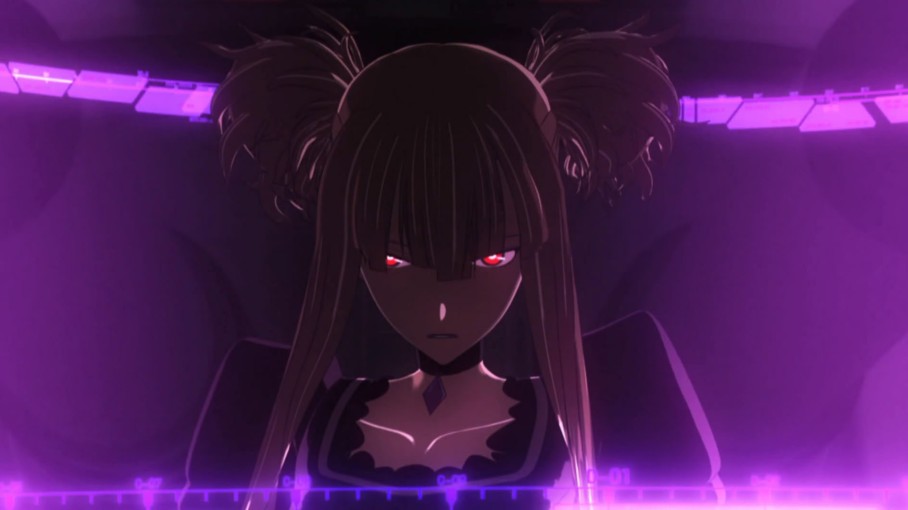

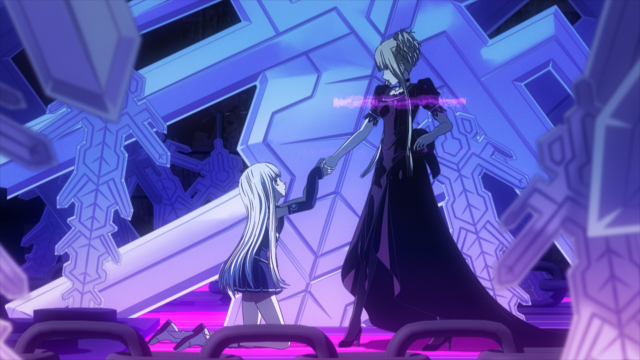
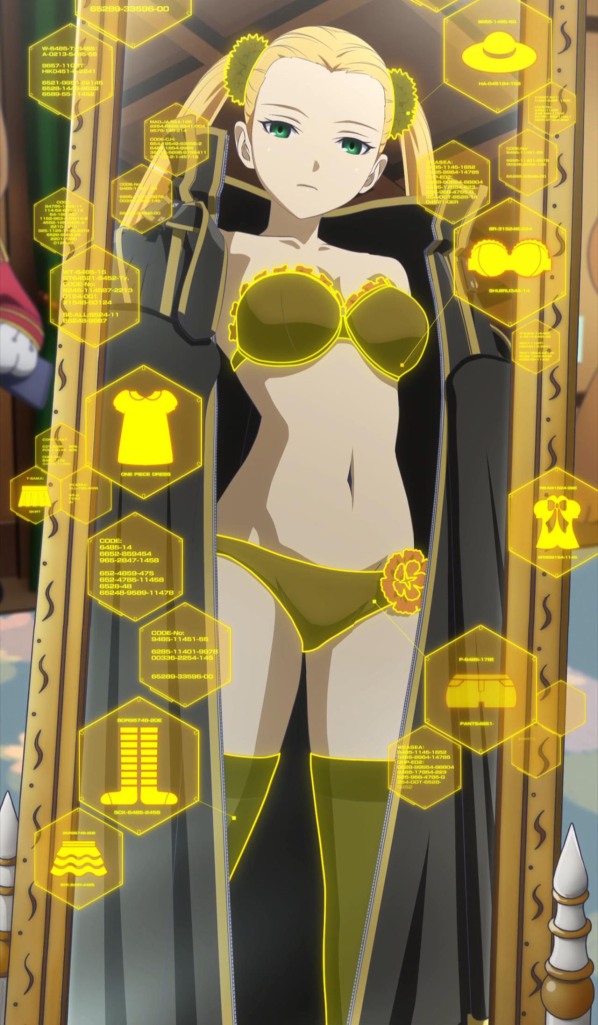

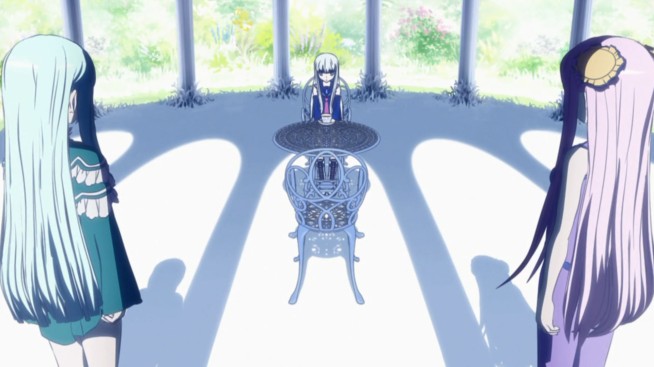
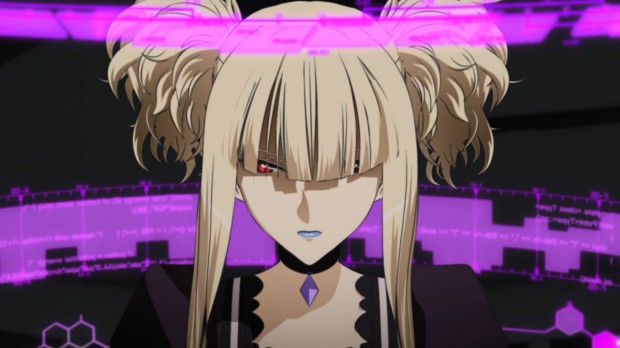
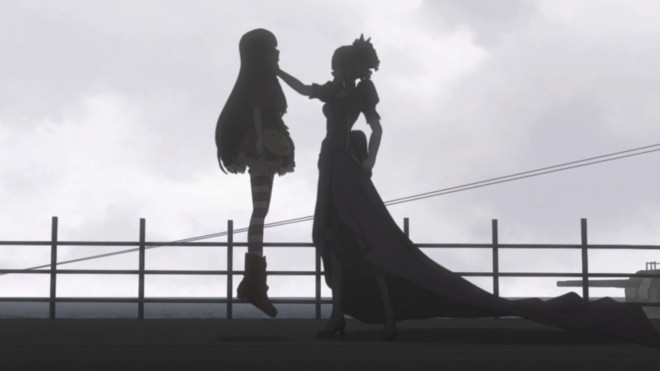
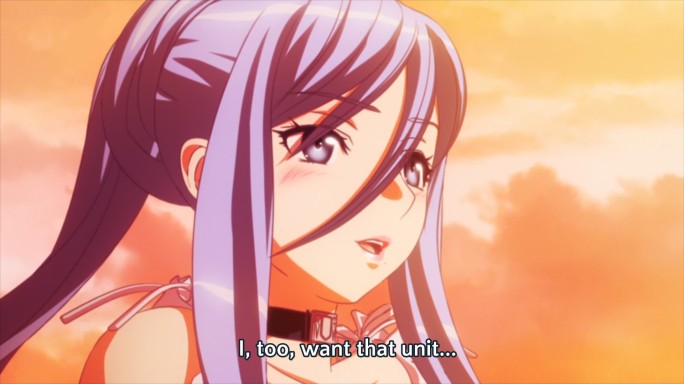
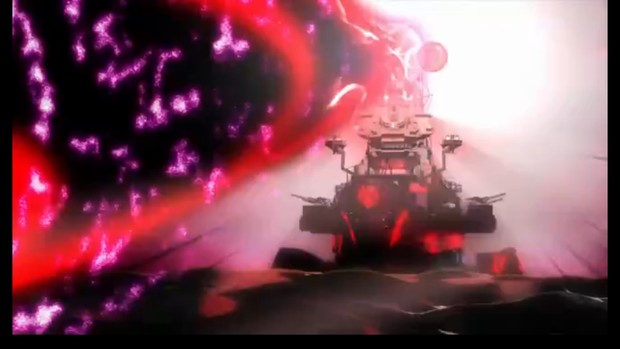

Pingback: Completely Predictable Post: Legend of Korra: Balance | Dataport Doll's Anime Reviews